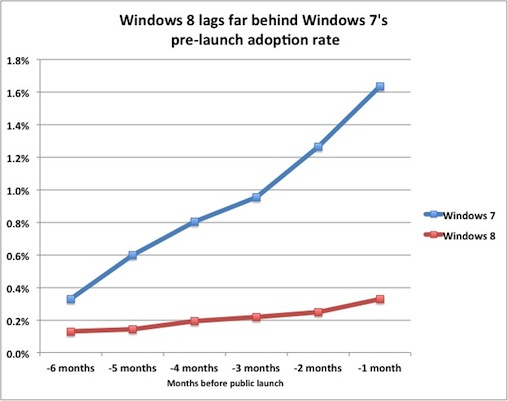With just weeks before the public launch of Windows 8,users are five times less likely to be running the new OS than they were Windows 7 at the same point in its countdown,an analytics firm said today.
The newest numbers from California-based Net Applications portray a tepid reception so far for Windows 8.
Unlike post-launch numbers,the early returns from Net Applications are not contaminated with those new PCs that come with an operating system pre-loaded.Rather,users chose to install the previews and finished code of Windows 8 and its precursor,providing a picture of customer interest in the OS itself,not in the desire or need to acquire new hardware.
Just 0.33%of all computers running Windows during September relied on Windows 8,Net Applications'statistics showed Monday.That number represents 33 out of every 10,000 Windows machines.
Microsoft to patch Windows 8,but stays mum on IE zero-day fixUpdate:Windows 8's early uptake lags behind Vista'sMicrosoft confirms zero-day bug in IE6,IE7 and IE8Windows 8's uptake falls behind Vista's paceMicrosoft unveils future retail store plansNORAD's Santa Cam tracking St.Nick's tripWindows 8 previews to go dark in 3 weeksConsumer Reports makes case for Windows 7 PCsOusted Windows exec Sinofsky to teach at HarvardNORAD switches from Google to Bing to track Santa Continuing coverage:Windows 8 At the end of September 2009,with essentially the same time remaining before its launch,Windows 7 accounted for 1.64%of all Windows PCs,or 164 out of 10,000:That's five times that of Windows 8 at its T-minus-one-month milestone.
Not only did Windows 8 stack up poorly against Windows 7 last month,but the gap between the two has widened.Three months ago Windows 8's share was one-fourth of Windows 7's.Since then the difference between them has increased,with Windows 8's September share only one-fifth of Windows 7.
In fact,Windows 8's September share of all Microsoft-powered computers was identical to Windows 7's share six months before that OS's launch,when users had had the beta for about three months but had yet to see the release candidate,much less finished code.
While Microsoft has not yet started selling Windows 8,developers,IT professionals and enterprises with volume license agreements have been able to obtain and run the"release to manufacturing"(RTM),or final,build since the middle of August.
The two operating systems have also had an equal opportunity to win hearts and minds:Microsoft delivered two early versions of each to the public,they reached their RTM milestones just 10 days apart,and their retail on-sale dates fall within the same week of October.
The poor pre-launch showing doesn't preclude Windows 8 from flourishing once new systems running it reach stores and the upgrade becomes available.Microsoft has discounted the Windows 8 upgrade to an all-time low of$40 in a deal that starts Oct.26 and ends Jan.31,2013;the price cut could jumpstart Windows 8 adoption.
But many analysts don't believe it will.
Just last week,Gartner said it would continue to advise its clients to essentially ignore Windows 8,and predicted that the OS would top out at a 20%to 25%share of corporate PCs.
Net Applications'data also highlights the difference between Windows 7 and Windows 8 in enterprises.At T-minus-two-months,Windows 7's share of all PCs jumped three-tenths of a percentage point,followed the next month by a four-tenths of point increase,the largest in all the months before its October 2009 debut.
Those increases could be attributed to the availability of Windows 7 RTM--on Aug.6,2009,for developers and IT pros,Aug.7 for enterprises with a Software Assurance plan--to a large chunk of customers.
Meantime,Windows 8 saw little"bounce"from its Aug.15 and Aug.16 RTM availability dates.Windows 8's T-minus-two-months increase was just three-hundredths of a percentage point,with a slightly-larger eight-hundredths of a point boost the next month.
Windows 8 will go on sale--and PCs and other devices with the OS will hit shelves--on Oct.26.Microsoft has slated a New York City launch event for the day before.

Windows 8's pre-launch uptake is extremely weak compared to Windows 7's adoption in 2009.





